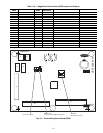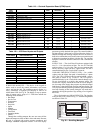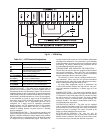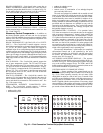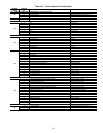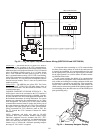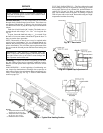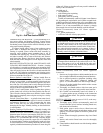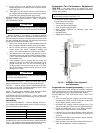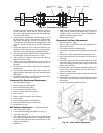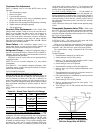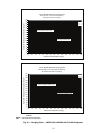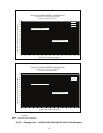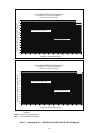
129
COMBUSTION-AIR BLOWER — Clean periodically to as-
sure proper airflow and heating efficiency. Inspect blower
wheel every fall and periodically during heating season. For the
first heating season, inspect blower wheel bi-monthly to deter-
mine proper cleaning frequency.
To inspect blower wheel, remove heat exchanger access
panel. Shine a flashlight into opening to inspect wheel. If
cleaning is required, remove motor and wheel assembly by
removing screws holding motor mounting plate to top of
combustion fan housing (Fig. 38 and 39). The motor, scroll,
and wheel assembly can be removed from the unit. Remove
scroll from plate. Remove the blower wheel from the motor
shaft and clean with a detergent or solvent. Replace motor and
wheel assembly.
ROUND TUBE PLATE FIN COIL MAINTENANCE AND
CLEANING RECOMMENDATIONS — Routine cleaning
of coil surfaces is essential to maintain proper operation of the
unit. Elimination of contamination and removal of harmful res-
idues will greatly increase the life of the coil and extend the life
of the unit. The following maintenance and cleaning proce-
dures are recommended as part of the routine maintenance ac-
tivities to extend the life of the coil.
Remove Surface Loaded Fibers
— Surface loaded fibers or
dirt should be removed with a vacuum cleaner. If a vacuum
cleaner is not available, a soft non-metallic bristle brush may
be used. In either case, the tool should be applied in the direc-
tion of the fins. Coil surfaces can be easily damaged (fin edges
can be easily bent over and damage to the coating of a protect-
ed coil) if the tool is applied across the fins.
NOTE: Use of a water stream, such as a garden hose, against a
surface loaded coil will drive the fibers and dirt into the coil.
This will make cleaning efforts more difficult. Surface loaded
fibers must be completely removed prior to using low velocity
clean water rinse.
Periodic Clean Water Rinse
— A periodic clean water rinse is
very beneficial for coils that are applied in coastal or industrial
environments. However, it is very important that the water
rinse is made with very low velocity water stream to avoid
damaging the fin edges. Monthly cleaning as described below
is recommended.
Routine Cleaning of Coil Surfaces
— Monthly cleaning with
Totaline
®
environmentally sound coil cleaner is essential to ex-
tend the life of coils. This cleaner is available from Carrier Re-
placement parts division as part number P902-0301 for a one
gallon container, and part number P902-0305 for a 5 gallon
container. It is recommended that all coils, including copper
tube aluminum fin, pre-coated fin, copper fin, or E-coated coils
be cleaned with the Totaline environmentally sound coil clean-
er as described below. Coil cleaning should be part of the unit’s
regularly scheduled maintenance procedures to ensure long life
of the coil. Failure to clean the coils may result in reduced du-
rability in the environment.
Avoid the use of:
• coil brighteners
• acid cleaning prior to painting
• high pressure washers
• poor quality water for cleaning
Totaline environmentally sound coil cleaner is non-flamma-
ble, hypoallergenic, nonbacterial, and a USDA accepted biode-
gradable agent that will not harm the coil or surrounding com-
ponents such as electrical wiring, painted metal surfaces, or in-
sulation. Use of non-recommended coil cleaners is strongly
discouraged since coil and unit durability could be affected.
Totaline Environmentally Sound Coil Cleaner Application
Equipment
•2
1
/
2
gallon garden sprayer
• water rinse with low velocity spray nozzle
Totaline Environmentally Sound Coil Cleaner Application
Instructions
1. Remove any foreign objects or debris attached to the core
face or trapped within the mounting frame and brackets.
2. Put on personal protective equipment including safety
glasses and/or face shield, waterproof clothing and
gloves. It is recommended to use full coverage clothing.
3. Remove all surface loaded fibers and dirt with a vacuum
cleaner as described above.
4. Thoroughly wet finned surfaces with clean water and a
low velocity garden hose, being careful not to bend fins.
5. Mix Totaline environmentally sound coil cleaner in a
2
1
/
2
gallon garden sprayer according to the instructions
included with the cleaner. The optimum solution temper-
ature is 100 F.
NOTE: Do NOT
USE water in excess of 130 F, as the enzy-
matic activity will be destroyed.
6. Thoroughly apply Totaline environmentally sound coil
cleaner solution to all coil surfaces including finned area,
tube sheets and coil headers.
7. Hold garden sprayer nozzle close to finned areas and
apply cleaner with a vertical, up-and-down motion. Avoid
spraying in horizontal pattern to minimize potential for
fin damage.
8. Ensure cleaner thoroughly penetrates deep into finned
areas.
9. Interior and exterior finned areas must be thoroughly
cleaned.
10. Finned surfaces should remain wet with cleaning solution
for 10 minutes.
Fig. 39 — Gas Heat Section Details
A48-3727
CAUTION
Harsh chemicals, household bleach or acid or basic clean-
ers should not be used to clean outdoor or indoor coils of
any kind. These cleaners can be very difficult to rinse out
of the coil and can accelerate corrosion at the fin/tube inter-
face where dissimilar materials are in contact. If there is
dirt below the surface of the coil, use the Totaline environ-
mentally sound coil cleaner as described above.
CAUTION
High velocity water from a pressure washer, garden hose,
or compressed air should never be used to clean a coil. The
force of the water or air jet will bend the fin edges and
increase airside pressure drop. Reduced unit performance
or nuisance unit shutdown may occur.



